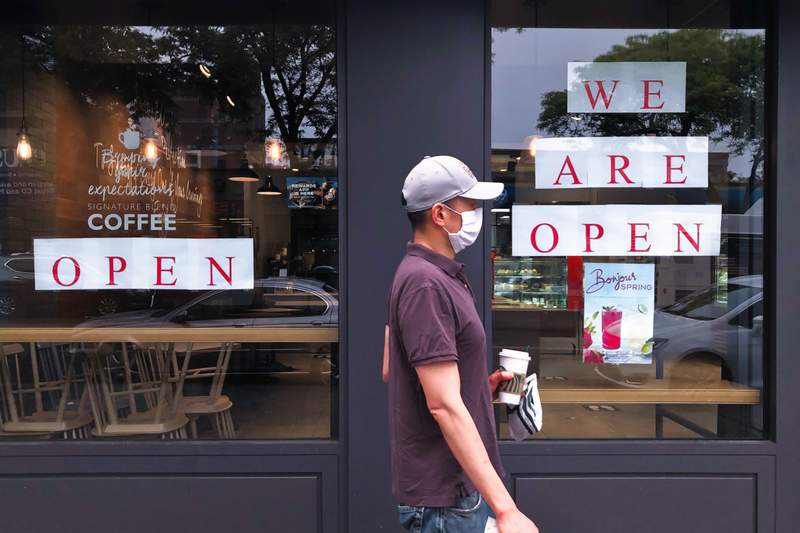(Bloomberg) -- After a surge in coronavirus cases across the U.S., all signs point to a slowdown in job gains last month -- or worse.
Friday’s employment report is forecast to show a 1.5 million increase in nonfarm payrolls in July, the median estimate in projections ranging from a 600,000 decline to a gain of 3.2 million. That’s following a combined rise of 7.5 million in May and June, which just started to make up the 22 million drop over the first two months of the pandemic.
The unemployment rate is projected to fall to 10.5% -- still triple the pre-crisis level -- from 11.1%.
An increase in new Covid-19 cases starting in mid-June, especially in the South and West, added further uncertainty to the economic rebound and spurred a slew of states to halt or reverse reopenings. While there’s little doubt the recovery has mostly stalled in recent weeks, economists’ forecasts for the July jobs numbers depend on how much weight is put on traditional and non-traditional indicators of employment.
ADP (NASDAQ:ADP) Research Institute data missed all estimates Wednesday, showing a 167,000 increase in private payrolls for July, though the initial figures from May and June both ended up being well below the government’s official numbers.
High Frequency Indicators
Looking at higher frequency labor-market indicators, the signals range from slower improvement to getting much worse.
Initial jobless claims for regular state programs have held in an elevated range of 1.3 million to 1.5 million. Continuing claims for those same programs have dropped by about 2 million during the period covered by the jobs report, a sign of hiring. In the most recent data, though, both measures have started to creep higher.
Meanwhile, an employment measure from Homebase -- a scheduling tool used by more than 100,000 local businesses -- has largely plateaued. St. Louis Fed economists said in a blog post that their index based on the data “suggests that the recent recovery in employment has halted.”
The Census Bureau’s Household Pulse Survey, which publishes weekly insights about Americans’ experiences during the pandemic, was even more downbeat. Comparing the mid-June and mid-July surveys, the number of Americans who said they were employed in the last seven days declined by about 6.7 million.
“If you put all of these together, it does point to a real stalling in the labor market in July,” said Oxford Economics senior economist Lydia Boussour, who forecasts a 280,000 decline in nonfarm payrolls.
More Momentum
Stephen Gallagher, chief U.S. economist at Societe Generale SA, disagrees. He’s estimating a 2.66 million payroll gain, pointing to likely increases in health care, personal services, manufacturing and construction, as overshadowing closures at bars and gyms.
“I think we just have a lot of momentum,” Gallagher said.
The timing of July’s renewed job losses is key. For instance, California, the nation’s largest state, closed indoor businesses during the reference period.
If the deterioration in employment actually coincided with the July survey reference week, the impact might not be seen until the August report, said Bloomberg economist Yelena Shulyatyeva. Bloomberg Economics changed its nonfarm payrolls estimate to a 500,000 gain from a 1 million decline.
The composition of job gains will be critical. Sectors such as manufacturing, construction and health care likely continued to rebound from their April lows. Yet hiring in sectors more vulnerable to a virus resurgence, like retail and leisure and hospitality, may have lost momentum amid renewed closures.
Non-federal government jobs could be a wild card. Typically there’s a steep decline in state and local education payrolls in July with the end of the school year, so the Bureau of Labor Statistics adjusts the figures higher to smooth the seasonal pattern. This year, however, education employment has already fallen greatly. Meanwhile, state and local governments are also facing steep revenue declines, squeezing state budgets, which could lead to further job losses.
The longer the pandemic has stretched on, the more businesses have had to make permanent cuts to headcounts -- in part because more firms are closing for good.
In April, about three-fourths of job losses were of a temporary nature. Each month, that share has fallen as the number of permanent job losers has continued to rise.
A systemic shift from temporary to permanent job losses suggests the labor market will recover more slowly, with many companies hesitant to hire new employees amid widespread economic uncertainty.
Another number to watch is the underemployment rate, or the U-6 rate, a more inclusive measure given it also reflects those who quit looking for a job because they were discouraged about their prospects and those working part-time but desiring a full workweek.
The number working part time for economic reasons has declined each month since April while remaining stubbornly high. Rather than laying off workers, many businesses have looked to cut hours or pay.
“A labor market recovery isn’t just increasing employment, it’s also making sure the people who do have a job are getting the number of hours they actually want,” said Nick Bunker, the economic research director for North America at jobs website Indeed.
©2020 Bloomberg L.P.
